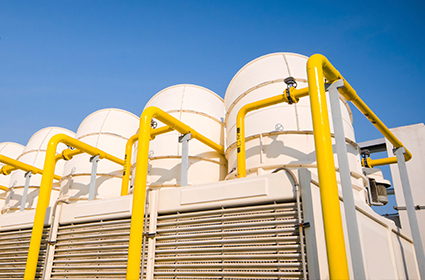Problem
A Midwestern university’s power plant has a closed cooling loop circuit that utilizes once through non-contact cooling water. The cooling water cools air compressors, sample coolers, and critical auxiliary equipment on a 10 megawatt generator. Compressed air from the plant is used to control HVAC pneumatics throughout the 320 buildings on campus, a highly critical operation.
The plant utilized untreated water from a nearby lake to supply its cooling system. To combat biological organisms that can cause system fouling inside the treatment pipes and components, the influent lake water was treated with chlorine before flowing through the cooling loop and discharging to the city. Utilizing lake water was a much lower volume sourcing cost than city water, an estimated $0.30-$0.50 per 1000 gallons compared to $5.00 for city water. This process also eliminated the need for using groundwater for operations and the small amount of water use from the lake is comparable to two weeks of evaporation in hot weather, ensuring the preservation of natural water resources.
In 2013, the university began treating the lake water with a sand ballast clarifier that utilized bleach to remove impurities. The downside to this treatment method was the large amount of wastewater being sent to the sanitary sewer drain. In 2017, a project was initiated by the plant, with consultation from U.S. Water to reduce the amount of sanitary sewer water sent from the plant to the city’s wastewater treatment plant, specific to once through cooling water.
Solution
The plant worked with U.S. Water to design a solution to maximize plant performance and minimize sewer costs. Piloting was used with lake water for once through cooling, and directly discharging the water back to the lake. To comply with the WPDES permit, the plant would need to discontinue the feed of chlorine to the non-contact cooling water. Due to the critical nature of these units, special considerations were evaluated and Key Performance Indicators (KPI) were used to verify that the heat exchangers were not fouling. KPI’s included differential pressure and differential temperature, influent bacterial monitoring, as well as visual inspections of the units when taken offline.
Result
In monitoring and examination, it was found that the air compressors could be operated with once through lake water, returning the water back to the lake without contamination that could be harmful to aquatic life. It was found that residual chlorine was gone from the systems and no organic buildup was materializing on the machinery. This change eliminated 70 million gallons of sewer discharge from 2016-2017. Flowing effectively, water now begins at a nearby lake and discharges into another local lake under the direction of Department of Natural Resources (DNR). Eliminating the discharge to a sanitary sewer has reduced emissions and energy usage and resulted in 70,090,400 gallon reduction in sanitary sewer volume from the plant. With sanitary sewer rates at $2.7389/1000 gallons, the annual savings to the university was calculated at $191,970 per year. Using sustainability metrics, this reduction is equivalent to the wastewater generated by 640 households in a single year.
Due to the high level of sustainability and savings, U.S. Water recognized this power plant with our 2017 Sustainability Award. The success with this project has led to additional projects that are currently underway.

